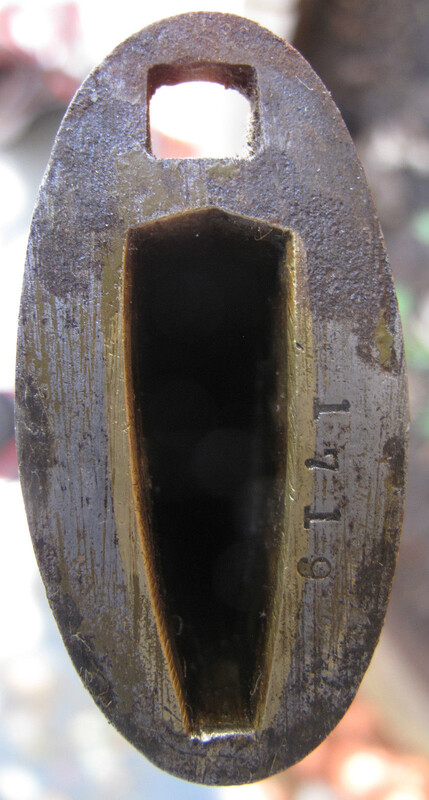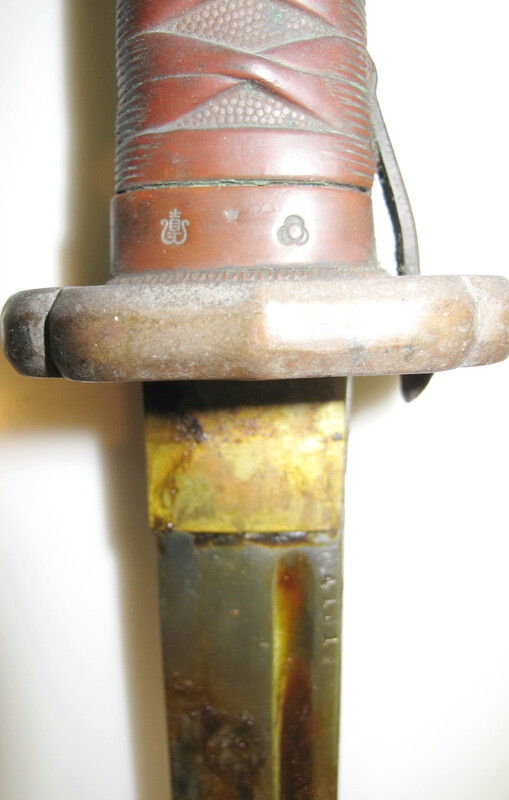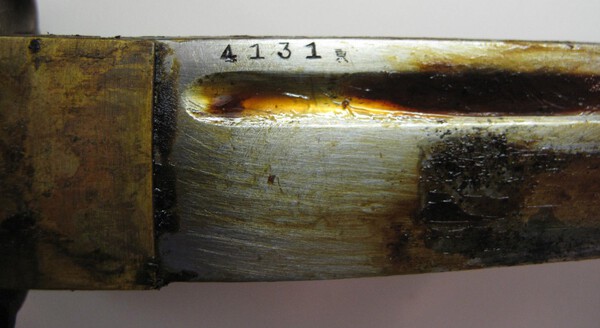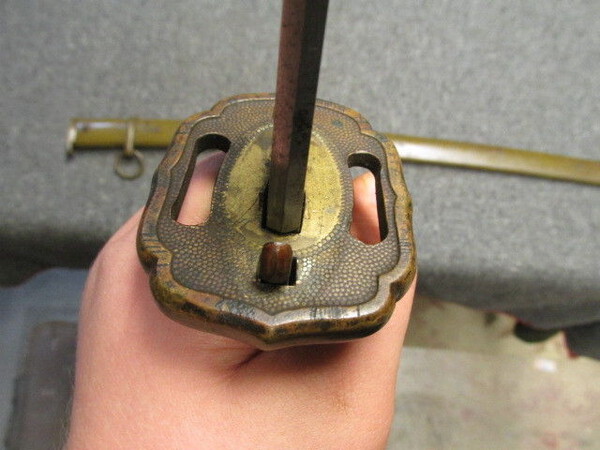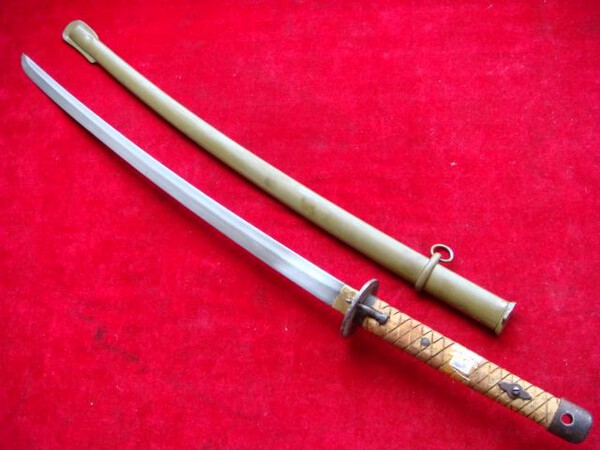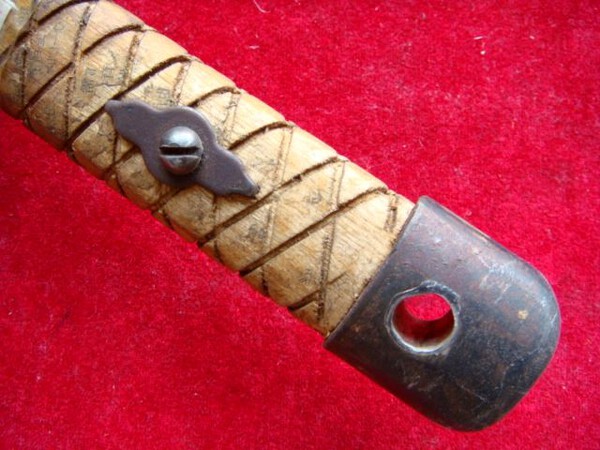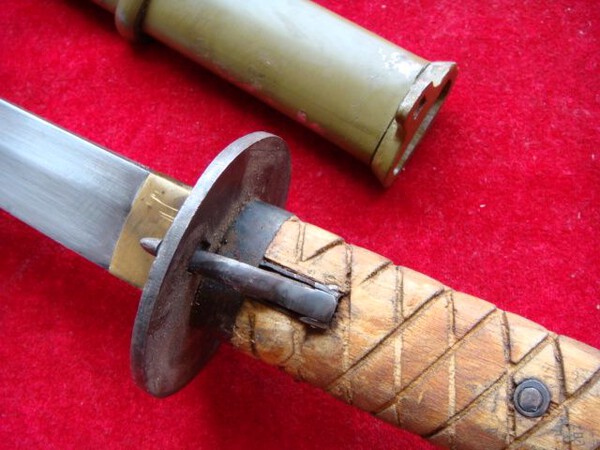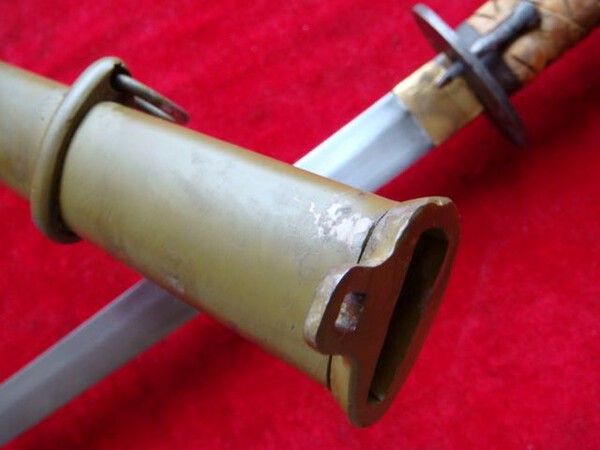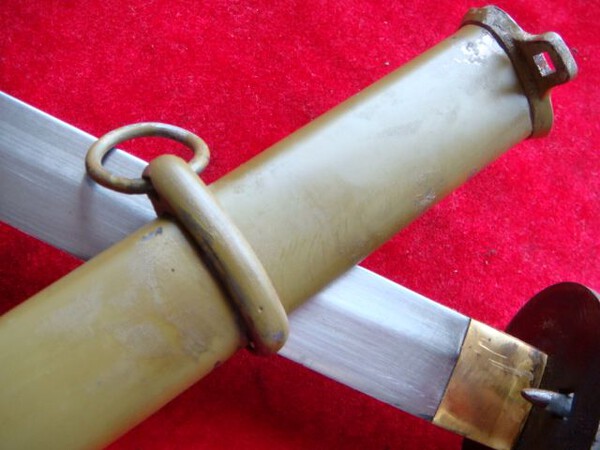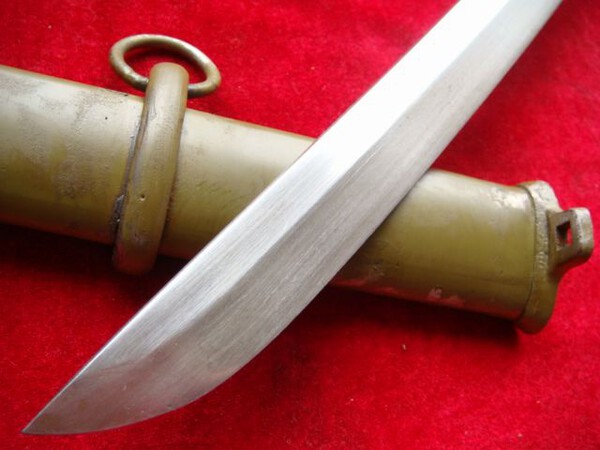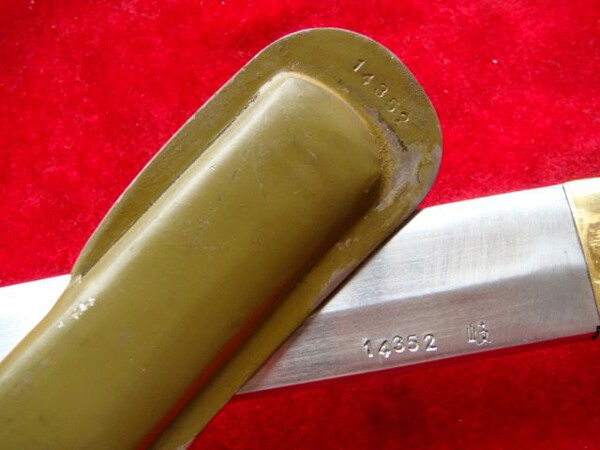-
Posts
422 -
Joined
-
Last visited
-
Days Won
9
Content Type
Profiles
Forums
Events
Store
Downloads
Gallery
Everything posted by Stegel
-
It is a genuine Type95 gunto, that is real and not a rotter! However, the condition appears to be a bit poor. If you are not in a hurry, i recommend waiting untill you come across a nicer example. Can you provide more pctures of the whole sword and scabbard? As Neil said, it's ok if the price is right.
-
This is why the education side of collecting is so important!! To a novice who buys on impulse........then asks in the forums..........you'll get BURNT This is a blatant fake, which you should keep well away from.
-
Neil, The stamp preceding the serial number and on the drag is ‘He’ . It is the Jinsen Army Arsenal Inspection Stamp from Pyongyang Heigo Factory, and is sometimes found in conjunction with the second class military weapon stamp.... the kanji for 2 inside a circle. You will only find these on the Patterns 6, 7, & 8. All the Wooden scabbard models. Sometimes you will also find it on the scabbard throat metal work and the fuchi area of these swords.
-
Well Wayne, Lowest wooden handle that i know of ,,,,, 201879 . This is only 18 digits higher...... with Fullered blade! Wayne, I assume your's is an Aluminium handle patterm 4??
-
Great observation Wayne! I have come across numerous different fonts across the different patterns, the fakes that come from china use a specific font aswell, which everytime i see it, gets me on guard straight away and i begin looking for other tell tale signs to confirm if it is genuine. I can only talk about the things i have observed over the years of my collecting, and mention them now. i would place the serial number stampings on all blades into 3 catagories, 1-Light 2-Normal and 3-Heavy. This appears to be across all Arsenals and is not specific to any one in particular. I suspect that you are spot on Wayne, the 'out sourcing' of parts meant that each supplier possibly had different fonts and applied varying pressure in stamping the blades/scabbards. With the inspection stampings, it was observed that the Tokyo 1st blades generally had good inspection stampings, whilst Nagoya blades had lighter stampings. This is put down to the hardening process where Tokyo 1st inspected and stamped the blades prior to hardening, whereas Nagoya inspected and stamped the inspection Kanji post hardening If you look at inspection stamps, all the aluminium handled side lock latch models in the 130k range have a lightly stamped Nagoya kanji preceding the serial number (ok there are a few with no inspection stamp also) In the 200k range, only a Seki Kanji is used. This also applies to scabbard stampings. This is also lightly stamped and precedeing the serial number. This continued on with the wooden handle pattern 5 in the 200k range.
-
Sorry Neil, I find it easier to think of them as Patterns, i've been doing it this way for years. I didn't mean to cause confusion. There were 8 Patterns produced on this gunto model. Pattern 1 is the copper handled version with brass tsuba and top lock latch. steel scabbard Pattern 2 is the aluminium handled version with brass tsuba and top lock latch. steel scabbard (ver 1 in Dawsons) Pattern 3 is the aluminium handled version with steel tsuba and top lock latch. steel scabbard (ver 2 in Dawsons) Pattern 4 is the aluminium handled version with steel tsuba and side lock latch. steel scabbard (ver 3 in Dawsons) Pattern 5 is the wooden handled version with steel tsuba and side lock latch. steel scabbard (ver 1 in Dawsons late war) Pattern 6 is the wooden handled version with steel tsuba and side lock latch. wooden scab (ver 2 in Dawsons late war) Pattern 7 is the wooden carved handled version with steel tsuba and side lock latch. wooden scab (ver 3 in Dawsons late war) Pattern 8 is the wooden ito wrap handled version with steel tsuba and side lock latch. wooden scab (ver 4 in Dawsons late war)
-
In the overall picture, yes your sword is early production. The earliest serial number i've seen is 130800. In this 100k range i estimate about 1800 swords with side latch were made, another 1200 in the 200k range. So all up only about 3000 were produced. Edit- perhaps i should explain the 1800 figure. The range is 130800 - 135000, but the pattern 3 (top lock latches) were also being produced in this range. About 44% were the side lock variants, and i'm working with a sample of 100 swords in this range.
-
Nice pick up Bruce, and you too Wayne! It's always satisfying to see a bit more completeness to your collection, isn't it! Neil, i think it was Brian, the Admin man who had the idea to run a militaria sub forum trial here. I think its picked up quite a bit and is getting to be a good sword related militaria forum. Here's a bit of info for some of you guy's who may be interested... This particular Pattern of Type 95 sword with side latch was made only by the Nagoya Arsenal, firstly under the Kokura Administration and then under it's own Administration. Less of these were made than the Copper handled versions (Pattern 1), but with collectors being what they are, and not all being the same, i suppose it is most desirable to have the very first pattern- hence the huge prices the Copper Handled variants generally command. This 4th pattern was introduced when the serial number range was at the 132k mark. An Administrative re-organisation occured which removed Kokura as the Supervisory Arsenal overlooking the type 95 production, and instead, Self Administration was granted to each Arsenal directly involved with the production. This meant that Tokyo 1st and Nagoya were directly responsible for the production and supervision of their own product. Logically, the Fuchi stampings also changed at this time, the stacked four cannon ball logo of the Kokura Arsenal was dropped and the Star with centre circle was used by Tokyo 1st while Nagoya used the circular 'sea creatures' logo. Most Importantly, the Serial number ranges were also divided with Nagoya beginning production in the 200k range, while Tokyo 1st continued within the current 100k range. Jinsen was allocated the 300k range. The Nagoya Arsenal (in the 132k range under Kokura) stopped the production of the previous Pattern 3 (Aluminium handle with top lock latch/steel tsuba) and moved it to the 200k range. This was later followed by the side lock version, resulting in this pattern being found in both ranges (100k and 200k). It was eventually replaced by the wooden handled variant not long after. I hope this came out right, and explains a bit, so as to answer any thoughts/questions/observations you guy's may have had on these particular versions. Cheers
-
You need to remove the 'sarute' or tassel loop before you can get to the screw itself. This loop is just a thick gauge wire essentially, and can be prised apart carefully -just enough to be pulled away from the screw and then from the tsuka. You should then be able to put it in the correct position and squeeze it back into it's correct shape. So no need to pull the screw apart at all...unless you want to take the handle off all together. Hope this helps. Steves method is a good way to go about it!
-
I'd have to agree with you on that, i personally find it interesting, but would never contemplate doing the same to a sword like that. It would have to detract and lower the overall value of it. The sword is however, genuine. The first 500 or so made, had a leather sarute as the seller stated. His is obviously well within this range and they also had the 'horse shoe' brass plug, which is also correct.
-
Hi Neil, here's a link to another forum where this was discussed and some examples posted as well. http://forums.gunboards.com/showthread.php?385909-Senior-NCO-Sword&highlight=SENIOR+SWORD have read as its easier than making a summary here. As far as Islander/colonial swords go, you should find it interesting i think. Cheers
-
Yes, i think thats what Bruce means. Are you able to take a clearer photo to post here? Cheers
-
Bruce, do you mean the 52627 sword?? If you do, it is not very clear at all, but i admit the shape is not the same as the To 東 stamp. It could be the Ho ホ stamp, which is the Kokura Army Arsenal First Factory, which i think is theTokyo 1st factory. I'll look into it and get back to you.
-
They weren't at first for me, but as i looked into them, the bug bit. Passion grew and it began to border on obsession and now i've been called a chronic case by some! By the way, i was looking at that sword for a friend of mine in NSW who (also got the bug) was chasing a copper handled sword to help complete his set.
-
Thanks for the photos Neil, they are both from the Tokyo 1st Arsenal while it was under Kokura Administration. I would love to see the copper handled sword you speak of, No: 1719. Is that the blade serial number? I would guess that the scabbard is a different serial number as i nearly bought a sword from St.Kilda over a year ago with that scabbard. The Blade was numbered 4131 . Heres some photos...
-
Neil, for someone who doesn't collect NCO swords, you've done alright!! Are you able to show us the serial nunber of the one with the combat covers to help determine if it is a Tokyo or Nagoya piece? Also a picture of the other side of the handle of the mint sword (tokyo produced)... any contractor markings? Cheers
-
Firstly welcome Neil , some fine looking pieces you have there, thanks for showing them to us! This one has definitely been pulled apart, most likely to see the nakago. Look at the seppa..... they are placed incorrectly on either side of the tsuba. I'm inclined to agree with you Steve, adter collecting these for over 20yrs, and only seeing 2 examples in that time, i think this is a bit tooo much of a coincidence for these to be genuine examples.
-
I think you're right too Bruce! That combined photo makes for easier comparison. Thanks
-
Yes Bruce, But i believe the saya is the same aswell, just from a different angle. The paint wear marks are almost identical....
-
I was just looking over Bob's pictures and noticed that his pictures and the ones of the fake i posted are actually the SAME sword! Guess they still haven't made too many others, or just keep using the same numbers to stamp.
-
A Fake Wooden Handle type 95 (1st variant with steel scabbard), the best one i've come across, actually probably the only one! It's a good one for you guys to find the red flags on. It would fool a lot of first time buyers with limited knowledge.
-
+1 All good for me too
-
Good topic Steve, as there is not much around on it to be found really. I see you've finally completed your set and also have my numbered 'ito warp' version too!! If i knew you were bidding on it i would of held back from my max bid....sorry. Your intro covered the range quite well, if you want me to add more anything in particular let me know. Bruce, that 'w' stamp is getting interesting, it just keeps showing up. BTW- i've come across a chinese copy of the 1st version wooden handled type 95, and posted it on another forum, i'll look for the pics to include it here if you like.
-
Hi All, I'm inclined to agree with it being a post war put together and not a prototype. There have been two such handles sold on ebay in the last 6 months or so, both painted and undrilled Aluminium types. The prototypes are not painted the same as the regular issued ones, they are anodised instead. These last of the 'pre-copper' handled prototypes also did not have habiki, the blade was thicker for about 40mm then formed to the normal blade shape...similar to the type 32 guntos issued at the time. Mark the one you sold a while back had been the same, but the latch fitting on the scabbard had been repaired by someone familiar with the type 95's as they did a good job on it.
-
That particular one in F&G is actually not a complete cover over the scabbard, it is a 'sleeve' some 8-10 inches (200-250mm) long. It converts the scabbard to a double hanger 'tachi' type of mount (as in the type94 or Naval gunto) It is not very common but a few samples have appeared over the last 10yrs or so. I would tend to agree with Thomas that most type 95's with wooden scabbards are post war mods, but then again in fairness, you cant rule out 'in the field' repairs and replacements, especially in the last year of the war, i would think.




